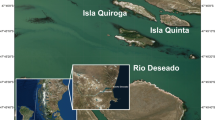Abstract
We have investigated genetic parentage in a Swiss population of tawny owls (Strix aluco). To this end, we performed genetic analysis for six polymorphic loci of 49 avian microsatellite loci tested for cross-species amplification. We found one extra-pair young out of 137 (0.7%) nestlings in 37 families (2.7%). There was no intra-specific brood parasitism. Our results are in accordance with previous findings for other raptors and owls that genetic monogamy is the rule. Female tawny owls cannot raise offspring without a substantial contribution by their mates. Hence one favoured hypothesis is that high paternal investment in reproduction selects for behaviour that prevents cuckoldry.
Similar content being viewed by others
References
Arlt D, Hansson B, Bensch S, Von Schantz T, Hasselquist D (2004) Breeding synchrony does not affect extra-pair paternity in great reed warblers. Behaviour 141:863–880
Arnold KE, Owens IPF (2002) Extra-pair paternity and egg dumping in birds: life history, parental care and the risk of retaliation. Proc R Soc B 269:1263–1269
Foerster K, Delhey K, Johnsen A, Lifjeld JT, Kempenaers B (2003) Females increase offspring heterozygosity and fitness through extra-pair matings. Nature 425:714–717
Fridolfsson AK, Gyllensten UB, Jakobsson S (1997) Microsatellite markers for paternity testing in the willow warbler Phylloscopus trochilus: high frequency of extra-pair young in an island population. Hereditas 126:127–132
Galeotti P (2001) Tawny owl. Update of the Birds of the western Palearctic 3:43–77
Griffith SC, Owens IPF, Thuman KA (2002) Extra pair paternity in birds: a review of interspecific variation and adaptive function. Mol Ecol 11: 2195–2212
Küpper C, Kis J, Kosztolányi A, Székely T, Cuthill IC, Blomqvist D (2004) Genetic mating system and timing of extra-pair fertilizations in the Kentish plover. Behav Ecol Sociobiol 57:32–39
Marks JS, Dickinson JL, Haydock J (1999) Genetic monogamy in long-eared owls. Condor 101:854–859
Marshall TC, Slate J, Kruuk LEB, Pemberton JM (1998) Statistical confidence for likelihood-based paternity inference in natural populations. Mol Ecol 7:639–655
Mauck RA, Marschall EA, Parker PG (1999) Adult survival and imperfect assessment of parentage: effects on male parenting decisions. Am Nat 154:99–109
Møller AP (2000) Male parental care, female reproductive success, and extrapair paternity. Behav Ecol 11:161–168
Møller AP, Cuervo JJ (2000) The evolution of paternity and paternal care in birds. Behav Ecol 11:472–485
Mundy NI, Woodruff DS (1996) Polymorphic microsatellite markers in the loggerhead shrike Lanius ludovicianus isolated from a library enriched for CA repeats. Mol Ecol 5:811–813
Neff BD (2003) Decisions about parental care in response to perceived paternity. Nature 422:716–719
Osorio-Beristain M, Drummond H (2001) Male boobies expel eggs when paternity is in doubt. Behav Evol 12:16–21
Otter K, Ratcliffe L, Michaud D, Boag PT (1998) Do female black-capped chickadees prefer high-ranking males as extra-pair partners? Behav Ecol Sociobiol 43:25–36
Pechacek P, Michalek KG, Winkler H, Blomqvist D (2005) Monogamy with exceptions: Social and genetic mating system in a bird species with high paternal investment. Behaviour 142:1093–1114
Petrie M, Kempenaers B (1998) Extra-pair paternity in birds: explaining variation between species and populations. Trend Ecol Evol 13:52–58
Raymond M, Rousset F (1995) Genepop (version 1.2): population genetics software for exact tests and ecumenism. J Hered 86:248–249
Roulin A, Müller W, Sasvari L, Dijkstra C, Ducrest AL, Riols C, Wink M, Lubjuhn T (2004) Extra-pair paternity, testes size and testosterone level in relation to colour polymorphism in the barn owl Tyto alba. J Avian Biol 35:492–500
Seutin G, White BN, Boag PT (1991) Preservation of avian blood and tissue for DNA analyses. Can J Zool 69:82–90
Sheldon BC (2002) Relating paternity to paternal care. Phil Trans R Soc Lond B 357:341–350
Spottiswoode C, Møller AP (2004) Extrapair paternity, migration, and breeding synchrony in birds. Behav Ecol 15:41–57
Stutchbury BJM (1998) Breeding synchrony best explains variation in extra-pair mating system among avian species. Behav Ecol Sociobiol 43: 221–222
Tregenza T, Wedell N (2000) Genetic compatibility, mate choice and patterns of parentage. Mol Ecol 9:1013–1027
Westneat DF, Sherman PW (1997) Density and extra-pair fertilizations in birds: a comparative analysis. Behav Ecol Sociobiol 41:205–215
Wink M, Dyrcz A (1999) Mating systems in birds: a review of molecular studies. Acta Ornithologica 34:89–109
Acknowledgments
The study was financed by the Swiss National Science Foundation (grants 31-53956.98 to H.R., P00A-102913 to A.R. and PP00A-109009 to P.B.). We are grateful to Pierre-Alain Ravussin for allowing us to study his tawny owl population. Blood sampling and capture of breeding tawny owls were conducted with legal authority from the “Service vétérinaire du canton de Vaud, no. 1508”.
Author information
Authors and Affiliations
Corresponding author
Additional information
Communicated by M. Wink.
Electronic supplementary material
Rights and permissions
About this article
Cite this article
Saladin, V., Ritschard, M., Roulin, A. et al. Analysis of genetic parentage in the tawny owl (Strix aluco) reveals extra-pair paternity is low. J Ornithol 148, 113–116 (2007). https://doi.org/10.1007/s10336-006-0109-x
Received:
Revised:
Accepted:
Published:
Issue Date:
DOI: https://doi.org/10.1007/s10336-006-0109-x



